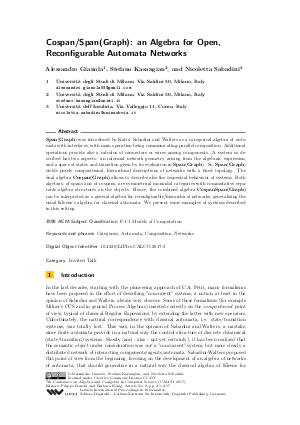Cospan/Span(Graph): an Algebra for Open, Reconfigurable Automata Networks
Authors Alessandro Gianola, Stefano Kasangian, Nicoletta Sabadini
-
Part of:
Volume:
7th Conference on Algebra and Coalgebra in Computer Science (CALCO 2017)
Part of: Series: Leibniz International Proceedings in Informatics (LIPIcs)
Part of: Conference: Conference on Algebra and Coalgebra in Computer Science (CALCO) - License:
 Creative Commons Attribution 3.0 Unported license
Creative Commons Attribution 3.0 Unported license
- Publication Date: 2017-11-17
File

PDF
LIPIcs.CALCO.2017.2.pdf
- Filesize: 0.94 MB
- 17 pages
Document Identifiers
Subject Classification
Keywords
- Categories
- Automata
- Composition
- Networks
Metrics
- Access Statistics
-
Total Accesses (updated on a weekly basis)
0PDF Downloads0Metadata Views
Abstract
Span(Graph) was introduced by Katis, Sabadini and Walters as a categorical algebra of automata with interfaces, with main operation being communicating-parallel composition. Additional operations provide also a calculus of connectors or wires among components. A system so described has two aspects: an informal network geometry arising from the algebraic expression, and a space of states and transition given by its evaluation in Span(Graph). So, Span(Graph) yields purely compositional, hierarchical descriptions of networks with a fixed topology . The dual algebra Cospan(Graph) allows to describe also the sequential behaviour of systems. Both algebras, of spans and of cospans, are symmetrical monoidal categories with commutative separable algebra structures on the objects. Hence, the combined algebra CospanSpan(Graph) can be interpreted as a general algebra for reconfigurable/hierarchical networks, generalizing the usual Kleene's algebra for classical automata. We present some examples of systems described in this setting.
Cite As Get BibTex
Alessandro Gianola, Stefano Kasangian, and Nicoletta Sabadini. Cospan/Span(Graph): an Algebra for Open, Reconfigurable Automata Networks. In 7th Conference on Algebra and Coalgebra in Computer Science (CALCO 2017). Leibniz International Proceedings in Informatics (LIPIcs), Volume 72, pp. 2:1-2:17, Schloss Dagstuhl – Leibniz-Zentrum für Informatik (2017)
https://doi.org/10.4230/LIPIcs.CALCO.2017.2
BibTex
@InProceedings{gianola_et_al:LIPIcs.CALCO.2017.2,
author = {Gianola, Alessandro and Kasangian, Stefano and Sabadini, Nicoletta},
title = {{Cospan/Span(Graph): an Algebra for Open, Reconfigurable Automata Networks}},
booktitle = {7th Conference on Algebra and Coalgebra in Computer Science (CALCO 2017)},
pages = {2:1--2:17},
series = {Leibniz International Proceedings in Informatics (LIPIcs)},
ISBN = {978-3-95977-033-0},
ISSN = {1868-8969},
year = {2017},
volume = {72},
editor = {Bonchi, Filippo and K\"{o}nig, Barbara},
publisher = {Schloss Dagstuhl -- Leibniz-Zentrum f{\"u}r Informatik},
address = {Dagstuhl, Germany},
URL = {https://drops.dagstuhl.de/entities/document/10.4230/LIPIcs.CALCO.2017.2},
URN = {urn:nbn:de:0030-drops-80535},
doi = {10.4230/LIPIcs.CALCO.2017.2},
annote = {Keywords: Categories, Automata, Composition, Networks}
}
Author Details
References
- L. d. F. Albasini, N. Sabadini, and R. F. C. Walters. The compositional construction of Markov processes. ArXiv e-prints, January 2009. URL: http://arxiv.org/abs/0901.2434.
- L. d. F. Albasini, N. Sabadini, and R. F. C. Walters. The compositional construction of Markov processes II. ArXiv e-prints, May 2010. URL: http://arxiv.org/abs/1005.0949.
- J. Bènabou. Introduction to Bicategories. Reports of the Midwest Category Seminar, 47:1-77, 1967. URL: http://dx.doi.org/10.1007/BFb0074299.
-
A. Carboni and R.F.C. Walters. Cartesian bicategories I. Journal of Pure and Applied Algebra, 49(1):11 - 32, 1987.

-
A. Cherubini, N. Sabadini, and R. F. C. Walters. Timing in the cospan-span model. Electr. Notes Theor. Comput. Sci., 104:81-97, 2004.

-
F. Gadducci, R. Heckel, and M. Llabrés. A bi-categorical axiomatisation of concurrent graph rewriting. Electronic Notes in Theoretical Computer Science, 29:80 - 100, 1999. CTCS '99, Conference on Category Theory and Computer Science.

-
P. Katis, N. Sabadini, and R. F. C. Walters. Span(graph): A categorial algebra of transition systems. In Proceedings of AMAST '97, pages 307-321, 1997.

-
P. Katis, N. Sabadini, and R.F.C. Walters. Bicategories of processes. Journal of Pure and Applied Algebra, 115:141-178, 1997.

-
P. Katis, N. Sabadini, and R.F.C. Walters. A formalization of the IWIM model. In Proceedings of Coordination Languages and Models 2000, volume 1906 of LNCS, pages 267-283. Springer, 2000.

-
R. Rosebrugh, N. Sabadini, and R.F.C. Walters. Generic commutative separable algebras and cospans of graphs. Theory and Applications of Categories, 15(6):164-177, 2005.

-
R. Rosebrugh, N. Sabadini, and R.F.C. Walters. Tangled circuits. Theory and Applications of Categories, 26(27):743-767, 2012.

-
N. Sabadini, F. Schiavio, and R.F.C. Walters. On the geometry and algebra of networks with state. Theor. Comput. Sci., 64:144-163, 2017.

